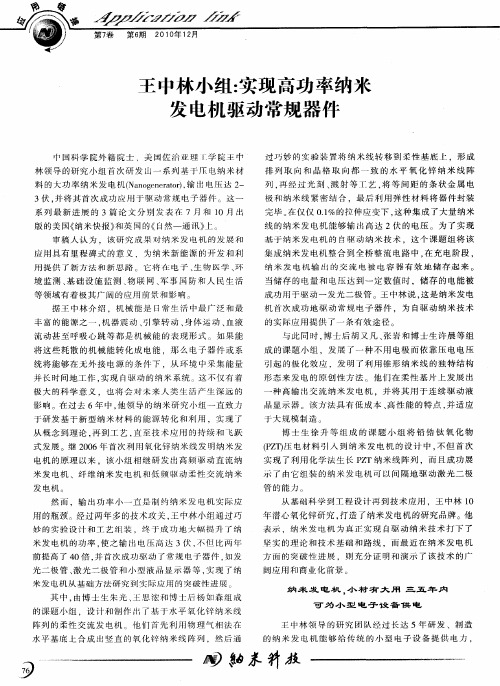纳米材料表征-王中林5 Scanning Probe Microscopy of Nanoclusters
- 格式:pdf
- 大小:736.49 KB
- 文档页数:31

现代分析方法纳米材料的表征与测试技术分析科学现代方法正是人类知识宝库中最重要、最活跃的领域之一,它不仅是研究的对象,而且又是观察和探索世界,特别是微观世界的重要手段,各行各业都离不开它。
随着纳米材料科学技术的发展,要求改进和发展新分析方法、新分析技术和新概念,提高其灵敏度、准确度和可靠性,从中提取更多信息,提高测试质量、效率和经济性。
纳米科学和技术是在纳米尺度上(0.1-100nm之间)研究物质(包括原子、分子)的特性和相互作用,并且利用这些特性的多学科的高科技。
纳米科技是未来高科技的基础,而适合纳米科技研究的仪器分析方法是纳米科技中必不可少的实验手段。
因此,纳米材料的分析和表征对纳米材料和纳米科技发展具有重要的意义和作用。
纳米技术与纳米材料是一个典型的新兴高技术领域。
虽然许多研究人员已经涉足了该领域的研究,但还有很多研究人员以及相关产业的从业人员对纳米材料还不很熟悉,尤其是如何分析和表征纳米材料、如何获得纳米材料的一些特征信息。
为了满足纳米科技工作者的需要,本文对纳米材料的一些常用分析和表征技术,主要从纳米材料的成分分析、形貌分析、粒度分析、结构分析以及表面界面分析等几个方面进行简要阐述。
1. 纳米材料的粒度分析1.1粒度分析的概念大部分固体材料均是由各种形状不同的颗粒构造而成,因此,细微颗粒材料的形状和大小对材料结构和性能具有重要的影响。
尤其对纳米材料,其颗粒大小和形状对材料的性能起着决定性的作用。
因此,对纳米材料的颗粒大小、形状的表征和控制具有重要意义。
一般固体材料颗粒大小可以用颗粒粒度概念来表述。
对于不同原理的粒度分析仪器,所依据的测量原理不同,其颗粒特性也不同,只能进行有效对比,不能进行横向直接对比。
由于粉体材料颗粒形状不可能都是均匀球形的,有各种各样的结构,因此,在大多数情况下粒度分析仪所测的粒径是一种等效意义上的粒径,和实际的颗粒大小分布会有一定的差异,因此只具有相对比较的意义。
此外,各种不同粒度分析方法获得的粒径大小和分布数据也可能不能相互印证,不能进行绝对的横向比较。

⑧浙江大学博十学位论文第一章绪论纳米是一种长度度量单位,即米的十亿分之一。
纳米材料是指在三维空间中至少有一维处于纳米尺度范围(1一100m)或者由它们作为基本单元构成的材料。
广义地说,纳米材料是泛指含有纳米微粒或纳米结构的材料。
1.1.1纳米材料的诞生及其发展早在】8世纪60年代,随着胶体化学的建立,科学家们就开始了对纳米微粒体系(胶体)的研究。
到20世纪50年代末,著名物理学家,诺贝尔奖获得者理查德·费曼首先提出了纳米技术基本概念的设想。
他在1959年12月美国加州理工学院的美国物理年会上做了一个富有远畿鬈0意黑2=:盏:篙翼盎:见性的报告,并做出了美妙的设想:如果有一天可以按人的意志安排一个个原子,那将会产生怎样的奇迹?理查德·费曼先生被称为“纳米科技的预言人”。
随后,1977年美国麻省理工学院的学者认为上述设想可以从模拟活细胞中生物分子的研究开始,并定义为纳米技术(nanotcchnology)。
1982年Binining和Rohrer研制成功了扫描隧道显微镜(s1M),从而为在纳米尺度上对表面进行改性和排布原子提供了观察工具。
1990年美国IBM公司两位科学家在绝对温度4K的超真空环境中用sTM将Ni(110)表面吸附的xe原子在针尖电场作用下逐一搬迁,⑧浙江大学博士学位论文电子既具有粒子性又具有波动性,因此存在隧道效应。
近年来,人们发现一些宏观物理量,如微颗粒的磁化强度、量子相干器件中的磁通量等亦显示出隧道效应,称之为宏观的量子隧道效应。
量子尺寸效应、宏观量子隧道效应将会是未来微电子、光电子器件的基础,或者它确立了现存微电子器件进一步微型化的极限,当微电子器件进一步微型化时必须要考虑上述的量子效应。
例如,在制造半导体集成电路时,当电路的尺寸接近电子波长时,电子就通过隧道效应而溢出器件,使器件无法正常工作,经典电路的极限尺寸大概在O.25um。
目前研制的量子共振隧穿晶体管就是利用量子效应制成的新一代器件。



王中林获首届全球纳米能源奖
佚名
【期刊名称】《中国科技奖励》
【年(卷),期】2017(0)8
【摘要】7月26日,在芬兰赫尔辛基举办的第四届纳米能源国际会议上,英国TheNANOSMATSociety学会会长NasarAli和大会主席PeterLund教授代表纳米能源奖委员会将2017年度全球纳米能源奖授予中国科学院外籍院士王中林,以表彰他在纳米科技特别是纳米能源领域的原创贡献。
【总页数】1页(P9-9)
【关键词】纳米科技;能源领域;中国科学院;国际会议;赫尔辛基;委员会
【正文语种】中文
【中图分类】TB383
【相关文献】
1.中科院外籍院士王中林获世界能源领域“诺奖” [J],
2.北京纳米能源所王中林院士获2014年材料领域“世界技术奖” [J],
3.能源王中林获世界能源领域最高奖系首位获奖华人科学家 [J], 周晨
4.纳米界领军型科学家王中林获“能源诺贝尔奖”系首位获奖华人科学家 [J], 经济日报
5.王中林院士荣获首届“全球纳米能源奖” [J],
因版权原因,仅展示原文概要,查看原文内容请购买。

《科学》周刊全文刊登王中林教授在纳米研究中的重大成果佚名
【期刊名称】《北京大学学报:自然科学版》
【年(卷),期】2006(42)3
【摘要】美国佐治亚理工学院讲席教授、北京大学工学院先进材料与纳米技术系系主任、中国国家纳米科学中心海外主任王中林教授和博士生宋金会成功地在纳米尺度下将机械能转换成电能,在世界上首次研制成功纳米发电机。
这一最新成果被本月13日出版的美国《科学》周刊长篇报道。
这一重大发现开启了纳米科学和技术的新篇章。
【总页数】1页(P400-400)
【关键词】纳米研究;《科学》;教授;国家纳米科学中心;纳米技术;先进材料;北京大学;纳米尺度;研制成功;机械能
【正文语种】中文
【中图分类】TB383
【相关文献】
1.创新开放产业化--访国家纳米科学中心海外主任、美国佐治亚理工学院校董事讲席教授王中林博士 [J], 王文
2.王中林教授在纳米研究中的重大成果世界最小发电机问世 [J],
3.国际纳米材料、纳米科技与电子显微学领域的著名科学家目前世界上纳米研究做得最好的五人之一美国佐治亚理工学院高塔(Hightower)终身讲席教授.终身校董事教授、工学杰出讲席教授中国科学院外籍院士,欧洲科学院院士--王中林
[J], 无
4.中国科学家王中林教授研制出纤维纳米发电机 [J],
5.纳米科学家王中林教授等研制出世界上最小发电机 [J],
因版权原因,仅展示原文概要,查看原文内容请购买。
纳米科技材料表征方法简介纳米科技是21世纪的重要领域之一,具有巨大的应用潜力和未来发展前景。
纳米材料是指其颗粒尺寸在1到100纳米之间的材料,具有独特的化学、物理和力学性质。
为了研究和开发纳米材料,科学家们需要了解其结构、形貌和组成。
这就需要使用一系列纳米材料表征方法来定量和定性地检测、分析和描述这些材料的特性。
在纳米科技领域中,有多种表征方法被广泛应用。
下面将介绍几种常见的纳米科技材料表征方法。
1. 扫描电子显微镜(SEM)SEM是一种广泛应用于纳米科技领域的表征方法。
它通过扫描样品表面并收集反射电子信号来获得样品的表面形貌和拓扑结构。
通过调整电子束的能量和角度以及探测器的位置和设置,可以获得不同放大倍数的样品图像。
SEM具有高分辨率、大深度和广泛的样品适用性。
2. 透射电子显微镜(TEM)TEM是一种用于观察纳米结构和化学成分的高分辨率显微镜。
它可以通过透射电子束穿过样品来获取样品的原子尺度的结构和形貌信息。
通过TEM,可以观察纳米材料的晶体结构、晶界、缺陷和杂质。
此外,TEM还可以用于元素的能量色散X射线谱分析(EDX)来获得样品的化学组成信息。
3. X射线衍射(XRD)X射线衍射是一种常用的材料结构表征方法,用于分析纳米材料的晶体结构和取向。
它通过测量样品衍射光的位置和强度来确定材料中晶格的特征。
通过XRD,可以确定纳米材料的晶体结晶度、晶胞参数和晶体取向。
此外,结合其他表征方法,如TEM和SEM,XRD可以提供全面的材料结构信息。
4. 傅里叶变换红外光谱(FTIR)FTIR是一种用于分析纳米材料组成和化学键的方法。
它通过测量材料对不同波长红外光的吸收谱来得到样品的红外光谱图。
由于不同的化学键和官能团对红外光的吸收具有特征性,因此可以通过FTIR来鉴定纳米材料的组成和化学结构。
5. 热重分析(TGA)TGA是一种用于研究纳米材料热稳定性和失重过程的表征方法。
它通过在控制温度条件下加热样品并测量其质量变化来分析样品的热分解、氧化和失重。
第一章纳米结构单元一、零维单元1.团簇(cluster)2.纳米微粒3.人造原子二、一维单元1.碳纳米管2.纳米棒、丝、线3.同轴纳米电缆4.纳米带5.纳米线研究进展一、零维单元1.团簇(cluster)(1)定义:是一类化学物种,指几到几百个原子的聚集体,粒径尺度小于1nm。
是介于单个原子与固态之间的原子集合体。
(2)组成:一元(含金属、非金属团簇),二元及多元原子团簇,原子团簇化合物(3)结构:以化学键紧密结合(除惰性气体外),球状、骨架状、四面体、葱状及线、管、层状等。
(4)物理性质:表面效应、量子尺寸、几何尺寸效应、掺杂物性等(5)研究:多学科交叉C60:寻找星际间分子而发现2.纳米微粒:超微粒子(ultra-fine particle)(1) 定义:尺寸在nm量级的超细微粒,尺度在1~100nm 之间,大于原子团簇,小于通常的微粒。
尺寸为红血球和细菌的几分之一,与病毒大小相当。
“要用TEM才能看到的微粒。
”(2) 性质:由微观到宏观世界的过渡区域,具有小尺寸效应、表面效应、量子尺寸效应和宏观量子隧道效应等。
特殊的微观机制→影响宏观性质(生物活性由此产生)(3) 研究:制备、合成和应用。
3.人造原子(artificial atom, super-atom)(1) 定义:尺寸小于100nm的、由一定数量的实际原子组成的聚集体。
包括:准0维的量子点、准1维的量子棒、准2维的量子圆盘、及100nm左右的量子器件(2) 特性:(量子效应)i) 与原子相似之处:a. 离散的能级和电荷b. 电子填充服从洪德定律ii) 与原子的差别:a. 含有一定数量的原子b. 形状、对称性多种多样c. 电子间的相互作用复杂d. 电子在抛物线形的势阱中,上层电子束缚弱(3) 应用:体系的尺度与物理特征量相当量子效应→新原理、新结构二、一维单元1.碳纳米管(Bucky Tube巴基管)发现:1991年,日本电气公司(NEC)高级研究员、名城大学教授饭岛澄男(Sumio Iijima)利用透射电镜首次观察到碳纳米管。
5ScanningProbeMicroscopyofNanoclustersLifengChiandChristianRöthig
5.1IntroductionTheinventionofthescanningtunnelingmicroscopy(STM)[1]presentsthebegin-ningofanovelclassofnear-fieldmicroscopywithnanometertillatomicresolutioninrealspace.OriginallytheSTMwasdesignedforthesurfaceanalysisunderultrahighvacuum(UHV)conditionsonconductingsurfaces.Itwasverifiedsoonthatthismethodcouldalsobeusedunderavarietyofenvironmentalconditionssuchasambi-entair[2],water[3],oil[4]andelectrolytes[5].Theseexcitingdiscoveriesmotivatedthefurtherdevelopmentofawholefamilyofotherscanningprobemicroscopes(SPM)[6].Examplesincludescanningforcemicroscopy(SFM)(oratomicforcemi-croscopy,AFM)[7]anditsextensions[8]andscanningnear-fieldopticalmicroscopy(SNOM)[9].TheapplicationsofSPMincreasedrapidlyinthelastdecade.SincetherequirementofaconductivesurfaceforSTMisnotthenecessaryconditionforSFM,theobjectsforSPMareextendedtoinsulatingmaterialsandcoverawiderangeofsurfacesofbulksystemssuchasmetals[10],semiconductors[11],adsorbatesonsolidsurfaces[12],polymers[13],biologicalmaterials[14]andorganiclayeredsystems[15].Besidesthefundamentalresearchofsurfacestructure,surfacemorphologyandsurfacerecon-struction,theSPMcanalsobeusedtoreveallocalphysicalpropertiesofthesample,e.g.electronicenergyspectrabyusinglocaltunnelingspectroscopy(LTS,orscanningtunnelingspectroscopy,STS),localtribologicalpropertiesbyusingfrictionalforcemi-croscopy(FFM),localelasticitybyusingforcemodulationmicroscopy(FMM),localmagneticpropertiesbyusingmagneticforcemicroscopy(MFM),andlocalelectro-staticpropertiesbyusingelectricforcemicroscopy(EFM).AnotherimportantapproachofSPMtechniquesisinthefieldofnano-lithography[16].Inrecentyears,nanometer-sizedclustersofmetalsandsemiconductorshavereceivedincreasingscientificandtechnologicalinterest[17].Introducingchemicallysynthesizedorphysicallyevaporatednanoclustersonavarietyofsurfacesisarecentapproachtogeneratenanostructuredsurfaces,whicharepromisingfornovelsensoric,electronicandphotonicdevicesandarethereforeinducingincreasedresearchactiv-ities.TheSPM,especiallySTMandSFM,canyieldvaluableinformationonnanoclus-tersastheymayrevealtheelectronicandgeometricstructureofthecluster's.Furthermore,theycanserveasidealtoolstocharacterizeclustercoveredsurfacessinceawiderangeofmaterialscanbechosenassubstratesforclusterdeposition.Inthefollowing,wewilldiscussthefundamentalprincipleofSPM(Section5.2)anddifferentoperatingmodesusedexperimentally(Section5.3).InSection5.4,se-lectedapplicationsofSPMonnanoclusterswillbepresented,including:
limagingofindividualnanoclustersandclustercoveredsurfaces
llocalphysicalproperties
lSPM-basedlocaldepositionandmodification
ltunnelingspectraofnanoclusters
CharacterizationofNanophaseMaterials.EditedbyZhongLinWangCopyright2000Wiley-VCHVerlagGmbHISBNs:3-527-29837-1(Hardcover);3-527-60009-4(Electronic)Besidesthetypicalnanocrystallinematerialspreparedwithgas-phasesynthesis,andorganicligandstabilizedmonocrystallineclusters,systemsdescribedherewillalsoincludethenano-scalemetallicdotsorislandsgeneratedbySTM/SFMtips,bynano-spherelithographyandbyelectrolessdeposition.ThelimitationofSPMmethodstostudythenanophasematerialsandtheprospectswillbegiveninSection5.5.
5.2FundamentalofthetechniquesThebasicideaofscanningprobemicroscopy(SPM)isrelativelysimple:takeaprobesusceptibletothepropertyonewantstomeasure,bringitintothevicinityofasurfaceandmeasurethereactionsoftheprobe.Asoneisinterestedinmicroscopicinformationtheprobehastobesufficientlysmallanditsmovementshavetobecon-trolledonalengthscalecomparabletoitssize.Bytakingmeasurementsatdifferentlocationsclosetothesurface,forinstancebyscanningtheprobeatconstantheight,atopographicrepresentationofthesurfacecanbegained.Dependingonthespecificpropertymeasured,thetypeofprobeandthewayinwhichthereactionoftheprobeisamplified,allexistingSPMmethodscanbedifferentiated.TheprobeinSPMisusuallyconnectedtoorconsistsoftheveryendofarigidtip.Themovementsofthistiprelativetothesurfacearecontrolledbyascannercon-structedfrompiezoceramicsinmostsetupswhichscanseitherthetiporthesurface.Thedistancebetweentipandsurfaceiscontrolledbyasimilartransducer,quiteoftenallthreetransducersarecombinedinasingularunitprovidingmovementinallthreespatialdirections.Ifoneisonlyinterestedinrecordingaspecialsurfacepropertyasafunctionofthespatialcoordinatesitissufficienttoamplifyandrecordthereactionsoftheprobeinaproperway.Iftheinterestisonconstant-property-mapsorifthepropertychangesverydrasticallywithslightchangesintip-sampledistance,afeed-backcircuitryofsomekindisnecessary.Withittheinterestingpropertyisheldcon-stantandthedistanceischangeduntiltheset-pointisreached.Byrecordingthedis-tanceasafunctionofthetwootherspatialdimensionsasurfaceplotcanbeproduced.Obviouslysuchaschemeisrelativelyeasytoimplementiftheinterestingpropertyisamonotonousfunctionofthedistance(interatomicforcesbeingaprominentexampleofamorecomplicatecase).Figure5-1showsatypicalsetupforSPMschematically.TheoldestSPMmethodwhichleadtoresolutionscomparabletothebestelectronmicroscopeswasscanningtunnelingmicroscopy(STM).Withitthelocalelectronicdensityofthesurfaceismeasuredbyapplyingasmallvoltagebetweentheprobeandsurface.Theprobeisusuallyformedbytheforemostatomofathinnedrigidpieceofwireandisconnectedviaasensitiveamperemetertothesurface.Iftheprobeapproachesthesurface,tunnelingofelectronsbetweensurfaceandtipcanbeob-served.ThistunnelingcurrentIisafunctionofeasilycontrollableindependentpa-rameterslikethecoordinatesoftheproberelativetothesurfaceandtheappliedvolt-ageanddependentparametersliketheworkfunctionofthesurfaceortheelectricconductivity.Thegeneralformofthetunnelingcurrentisgivenby